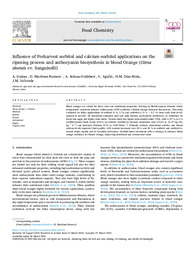Título :
Influence of Preharvest sorbitol and calcium-sorbitol applications on the ripening process and anthocyanin biosynthesis in blood Orange (Citrus sinensis cv. Sanguinelli) |
Autor :
Guirao, Alberto
Martínez-Romero, Domingo
Solana Guilabert, Ander
Diaz-Mula, Huertas Maria 
Veracruz, Valverde  |
Editor :
Elsevier |
Departamento:
Departamentos de la UMH::Tecnología Agroalimentaria |
Fecha de publicación:
2025 |
URI :
https://hdl.handle.net/11000/37690 |
Resumen :
Blood oranges are valued for their color and nutritional properties, thriving in Mediterranean climates where temperature variations enhance anthocyanin (ACN) synthesis. Climate change threatens this process. This study evaluated six foliar applications of sorbitol (2 %, 5 %) and sorbitol-Ca (2 % + 0.7 %) from early fruit development to harvest. All treatments enhanced peel and pulp redness, particularly sorbitol-Ca, as confirmed by lower hue angle and higher color index. Treated fruits had higher total soluble solids (TSS), with 11.07 % in 2 % sorbitol-treated fruits versus 9.63 % in controls. Sorbitol-Ca reduced respiration rates (15.63 vs. 21.57 mg CO₂ kg−1 h−1) and increased firmness (9.72 vs. 8.89 Nmm−1). Phenolic content, antioxidant activity, and bound calcium levels improved fruit quality. ACN content increased over 20 % and 40 % in sorbitol- and sorbitol-Ca-treated fruits, mainly due to Cyanidin derivatives. Sorbitol-based treatments offer a strategy to enhance blood orange resilience to climate change, improving functional and commercial value.
|
Palabras clave/Materias:
Citrus sinensis L. Osbeck
Minerals
Quality
Polyols
Antioxidant
Sugars
Organic acids |
Área de conocimiento :
CDU: Ciencias aplicadas |
Tipo de documento :
info:eu-repo/semantics/article |
Derechos de acceso:
info:eu-repo/semantics/openAccess |
DOI :
https://doi.org/10.1016/j.foodchem.2025.144105 |
Publicado en:
Food Chemistry Volume 481, 30 July 2025, 144105 |
Aparece en las colecciones:
Artículos Tecnología Agroalimentaria
|
 La licencia se describe como: Atribución-NonComercial-NoDerivada 4.0 Internacional.
La licencia se describe como: Atribución-NonComercial-NoDerivada 4.0 Internacional.
.png)
